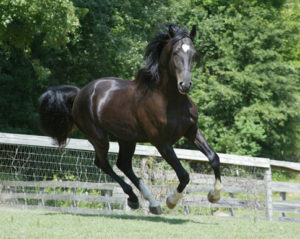A breeding soundness exam is a useful tool that stallion owners and managers can use to evaluate the reproductive status of their stallion. The objective of a breeding soundness exam (BSE) is to determine if a stallion has the mental and physical ability to produce viable offspring without spreading infectious disease. While this type of evaluation is critical to determine the number of mares a stallion can successfully cover in a given year, most often this step is overlooked until there is a problem. While the specifics of a BSE may vary between veterinarians, each evaluation should include:
- Reproductive History– This history needs to be complete in order to avoid inaccuracies. The following information should be collected: age; present number of mares covered, including their pregnancy rate, foaling rate, or infection; data from previous evaluations; lameness; illness; fertility issues; current medications; health status; and intended method of breeding.
- Physical Exam– While a breeding soundness exam mainly focuses on the reproductive health of a stallion, the general health of the animal should not be overlooked. It is important to positively identify the stallion to prevent legal complications, and then to focus on the body condition score of the animal. Attention should be paid to any abnormality (physical or genetic) that may inhibit the animal’s ability to mate successfully without passing on negative heritable conditions, including lameness or back pain.
- Reproductive Genitalia Exam– An evaluation of the reproductive anatomy is also important. The stallion’s penis, sheath, testes, and epididymis should be anatomically correct, functional, and free from injury or disease. Size, shape, and consistency of the testes and epididymis should be noted. A veterinarian may choose to use a set of calipers or an ultrasound to determine the overall volume of each testicle, which is a valuable measurement that helps determine the stallion’s daily sperm output.
- Sexual Behavior– Some stallions may have an aversion to displaying natural breeding behavior based on their previous training. For example, stallions that are used as performance animals and are shown are expected to behave and not display breeding behavior. The training used to teach them to control this natural behavior may create difficulties in the breeding shed. During a breeding soundness exam, a stallion should have immediate interest and interaction with a mare in heat, should obtain an erection within 2 minutes, display a readiness to mount within 5-10 seconds following erection, and should ejaculate on first mount. The total breeding time should not take longer than 5 minutes. A young stallion or one who does not display normal breeding behavior may need additional training by an experienced handler.
- Semen Evaluation– Specialized equipment is used to evaluate the volume, concentration, motility and morphology of a semen sample. The color and consistency of the sample is evaluated along with contents such as debris, urine, or blood. This evaluation determines the number of viable sperm cells available, which indicates the number of mares a stallion can breed per collection. In special circumstances additional testing to rule out any reproductive dysfunction may be needed.
While a breeding soundness exam can give stallion owners an indication of potential reproductive soundness, it does not measure fertility. In order to “pass” a breeding soundness exam, a stallion’s second ejaculate, which is collected one hour after the first, must contain at least “1 billion progressively motile, morphologically normal spermatozoa.” Advanced breeding technologies exist to help extend the breeding career of stallions. Therefore, managing your stallion’s overall health and reproductive soundness with your veterinarian can extend its overall career and impact on the equine industry.
References:
- Squires, E. 2015. A Stallion Breeding Soundness Exam. SRS Breeders Blog.
- Samper, J.C. 2009. Equine Breeding Management and Artificial Insemination. 2nd Edition
- Bedford-Guaus, S.J. 2014. Breeding Soundness Examiniation of Stallions. The Merck Veterinary Manual.






